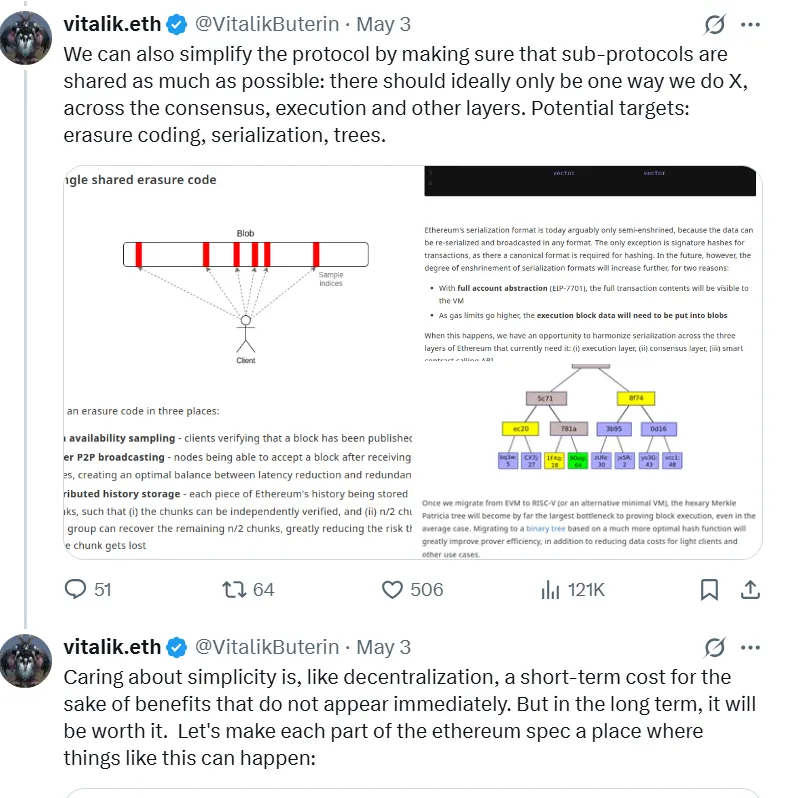
Vitalik Buterin Suggests Significant Ethereum Upgrade 2025
The co-founder has presented a wide ranging proposal to facilitate the Ethereum protocol, deriving inspiration from Bitcoin’s streamlined and adaptable design. In a blog post titled “The 3 Transitions: Simplifying the L1,” published on May 3, 2025, Buterin voiced concerns about increasing complexities of it’s technical architecture. He noted that although the recent updates such as shift to proof-of-stake and adoption of zero-knowledge (ZK) technologies, have enhanced the network’s capabilities. They have also made it more challenging to manage and evolve. Ethereum upgrade 2025 has layered the system with intricate components, complicating coordination, auditing, and driving up the risks of bugs, delays, and implementational costs.
Buterin aims to build it's consensus mechanism uncomplicated and more productive. Instead of the current complex system, that involves epochs, sync committees, and constant validator shuffling, he suggests a ‘3-slot finality’ model, where blocks are finalised every three slots. These would reduce the need for frequent validator rotations, making the network more predictable and easier to manage in Ethereum upgrade 2025.
A major benefit of Ethereum upgrade 2025 is reducing the number of active validators, from hundreds of thousands to just a few thousand. Fewer validators mean less network complexity, lower computational overhead, and stronger security.
Key points:
Change: Retire complex validator shuffling with a simple ‘3-Slot Finality’ system.
Benefits: Quicker Block finalisation, fewer validators required, and dependability.
Extra Upgrade: STARK proofs to improve speed and decentralisation.
Overall, these changes could make it faster, lighter, and more scalable, taking inspiration from Bitcoin’s simplicity while maintaining Ethereum’s advanced capabilities.

Source: X
Buterin suggests replacing Ethereums’s current system (the EVM) with a simler, faster alternative, RISC-V, an open-source technology often used in modern computing.
Key Changes and Benefits:
Better for Privacy and Scaling
RISC-V works much better with zero-knowledge proofs (key for privacy and scaling), potentially making proofs hundred times faster.
This would accelerate transaction processing and lower operational cost .
2. Smoother Transition
The EVM would not disappear overnight, it would run on top of RISC-V at first.
Developers could keep using existing apps while gradually adapting to the new system.
3. Simpler and More Efficient
RISC-V is easier to optimize and maintain long-term than EVM.
This could make it lighter, faster, and more secure.
Ethereum upgrade 2025 could dramatically improve the performance while keeping it compatible with the existing apps, a win-win situation for both developers and users.
Alongside changes to consensus and execution, Buterin emphasises the importance of simplifying its shared infrastructure. He calls for standardising key elements like data serialisation, tree structures, and error correction methods. Ethereum upgrade 2025 includes using one erasure coding scheme, adopting SSZ (Simple Serialize) for all data, and applying a uniform Merkle tree structure throughout the protocol. He also recommends setting a limit on the amount of code in core consensus logic to keep it simple and easy to audit. Legacy features that aren’t essential would still be supported, but moved outside the main protocol to reduce complexity and improve security.
A Strategic Ethereum Upgrade 2025, Roadmap to Ensure Future Competitiveness:
Vitalik Buterin is pushing for simplifications; it faces tougher competition from faster and cheaper blockchains like Solana. While Ethereum is still at the top for smart contracts, it’s been losing users due to:
High fees
Network Congestion
Complexity for developers
Buterin wants to: Strip down Etherum’s core tech, just like Bitcoin’s ‘less is more’ philosophy to Make it easier to maintain and upgrade. Help developers build without struggling with the complexities.Think of it like decluttering a phone just to make it run faster and smoother. So, instead of adding more features, it might succeed by becoming leaner and more efficient. Though these changes will take around 5 years.
Sheetal Jain is a seasoned crypto journalist, content strategist, and news writer with over three years of experience in the cryptocurrency industry. With a strong grasp of financial markets, she specializes in delivering exclusive news, in-depth research articles and expertly optimized on-page SEO content. As a Crypto Blog Writer at CoinGabbar, Sheetal meticulously analyzes blockchain technologies, cryptocurrency trends and the overall market landscape. Her ability to craft well-researched, insightful content, combined with her expertise in market analysis, positions her as a trusted voice in the crypto space.